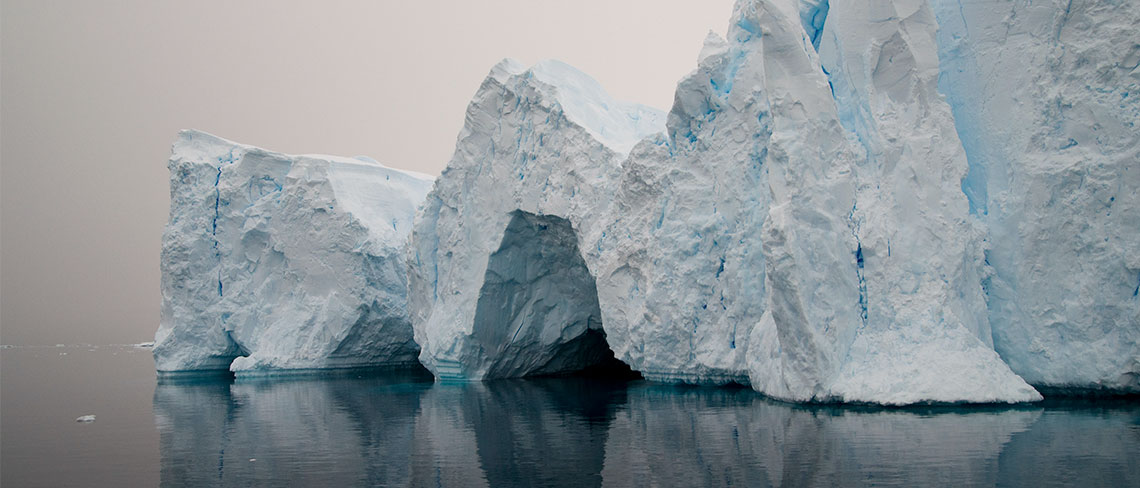
Get beneath the surface of expedition cruising (in some cases, quite literally) with insights from Director of New Scientist Discovery Tours.
Since the start of 2022, New Scientist Discovery Tours, the UK’s leading provider of science-inspired tours, has seen an increasing appetite for expedition cruising, a form of travel which entails visiting remote places to discover largely untouched environments (often following in the footsteps, or rather the wake, of the world’s great explorers).
Kevin Currie, Director of New Scientist Discovery Tours says, “Between 2022 and 2023, we increased the capacity of our marine-focused tours by 286% to meet rising demand. As we move into 2024, we have not seen any signs of this appetite slowing, which is why we have introduced three new expedition cruise tours for next year alone.
“The rising popularity of expedition cruising, with its promise of awe-inspiring, off-the-beaten-track experiences, is unsurprising considering consumers’ increasing desire in recent years for experiential, mind-nourishing, and unique travel.
“This rise of experiential cruising can also be credited, in part, to the ability of tour providers to meet the growing demand. Thirty new ships have been brought onto the polar cruising market in the last five years and significant advances in technology have been made, such as changes to the X-BOW hull design and introduction of digital anchoring, allowing ships to visit more fragile, protected marine environments by reducing the risk of environmental impact.”
Discover more about the past, present, and future of experiential travel below, alongside a list of expedition cruise tours to book this year (some new for 2024)…
Recent developments to expedition cruises and the vessels used
In the past five years, thirty new ships have come into the expedition market for polar cruising, with many new developments having been introduced to enhance both the customer experience and the operation process.
Where the majority of expedition ships were formerly Russian owned ex ice breakers, which have now been returned, expedition companies were forced to look at other sources to obtain their ships. In many cases, these companies have instead opted for building their own and have been able to incorporate new features.
One trend that New Scientist Discovery Tours has witnessed is an increase in the number of small ships being introduced, with many now featuring an X-BOW hull design – thought to be a true game changer in the industry.
Smaller ships make access to smaller bays and ports a lot easier, so guests can get even closer to the wildlife and more time can be spent on land at the various stop off points as opposed to disembarking and boarding the ships.
Game-changing, environmentally friendly tech advances
Further to this, the design of the X-BOW hull has a vast number of environmental benefits, primarily its ability to cut through the waves in a much smoother fashion, in turn consuming less fuel and therefore producing fewer emissions. In terms of the customer experience, the design reduces the impact and slamming loads, making for much gentler sailing.
Examples of where this X-BOW hull design can be seen is on the expedition ship, the Greg Mortimer, the base for New Scientist Discovery Tours’ Science of the Arctic expedition cruise in Svalbard, Norway. As well on this expedition ship, it can be seen on the Sylvia Earle, the base for New Scientist Discovery Tours’ The science of the deep Antarctic expedition cruise.
In addition to these advancements in operational technologies, a lot of the new expedition ships now also have specific on-board citizen science programmes and dedicated labs where research experts are collecting and analysing data relating to the natural world. Gathering and sharing this data is a great way to engage and educate the guests in pressing issues that impact the local, regional, and global environments.
A key piece of technology that has come about recently to avoid damaging the seabed floor is digital anchoring. The technology combines the use of a GPS to keep the position stable with the light use of thrusters to keep the ship in place.
This soft anchoring approach proves particularly useful when trying to anchor in more fragile marine environments and is a positive contribution towards marine conservation.
Future Trends of Expedition Cruises
Looking to the future, New Scientist Discovery Tours expects there to be an increase in submersible craft, either via remote control systems or those that can actually take guests into the sea.
In some scenarios, for example, if someone is looking to explore the fumaroles in Northern Iceland, they would need to be an experienced diver in order to swim 20 metres deep. With the introduction of remote-control submersible craft, individuals will be able to witness this amazing natural phenomenon whilst remaining just above it, within the safety of the vessel.
Currently in Antarctica, permits are required which restrict the number of visitors allowed at a landing site at one given time, and therefore limit the environmental impact of expedition cruising. There are talks of this being rolled out to the Arctic region in the next few years. This will lessen the environmental impacts in the region, but will mean that larger ships won’t be able to stop at certain key locations.
Please see a selection of New Scientist Discovery Tours’ very own expedition cruises below, available to book now.
NEW for 2024 – Price from £11,399pp, departing 23 March 2024 for 15 days
- Exclusive talks, commentary, and insights from Alison George, a features editor at New Scientist who has overwintered in Antarctica with the British Antarctic Survey
- Talks and activity support from onboard expedition team and Saunders Carmichael-Brown, a producer/presenter who was on the Endurance 22 Antarctic Expedition that found Sir Ernest Shackleton’s shipwreck
- 2 night’s hotel accommodation and 12 days aboard the polar expedition vessel, the Sylvia Earle, on a full-board basis
- Full touring itinerary (including all zodiac cruising, landing activities, a coastal catamaran cruise from Ushuaia and half day tour of Tierra del Fuego National Park, and internal transfers)
This 15-day tour takes guests on a trip of a lifetime to one of the most remote, breathtaking regions of Antarctica, the Weddell Sea – a place where waters have been declared by scientists as the clearest on Earth. Tour highlights include the chance to witness humpback whales, Weddell seals, and Adelie penguins, guided hikes (exploring pristine beaches and stunning wilderness), and boat safaris (investigating coves, icebergs and wildlife). Guests journey of discovery will be facilitated by incredible insights from experts in the field, with talk topics ranging from how microbes rule Antarctica to how to film in its unique conditions.
Price from £9,995, departing 18 June 2024 for 13 days
- Private talks and informal seminars from New Scientist’s Rowan Hooper and the polar expedition team
- 2 night’s accommodation at four-star hotels, including the world’s northernmost full-service hotel, and 10 nights aboard the Greg Mortimer, a new state-of-the-art polar expedition vessel, on a full board basis. This ship has one of the smallest capacities in expedition cruising (132 passengers maximum)
- Full touring itinerary (including all zodiac cruising and landing activities led by the expedition team, port surcharges, permits and landing fees)
This 13-day tour takes guests on a marine expedition to the northernmost region of Earth to explore a remote and rugged archipelago, home of both the polar bear and the midnight sun. With a full programme of talks from New Scientist’s Rowan Hooper and the polar expedition team, shore visits, tundra hikes, and Zodiac boat safaris, guests will get to immerse themselves in the wonders of Norway’s Svalbard – with its ancient glaciers, glass-still fjords, and array of wildlife, from walruses and puffins to little auk colonies and polar bears.
Price from £7,585pp, departing 26 September 2024 for 13 days
- Accompanied by the most experienced guides in the region as well as crew members with over 30 years of operations expertise
- Accommodation on bed and breakfast basis, 10 lunches, 11 dinners, aboard Tucano, a classic river boat and motor yacht, and at the Pousada do Rio Mutum Ecolodge and Juma Opera Hotel
- Full touring itinerary (including the domestic flight from Manaus to Rio Grande, all entrance fees, visits, excursions and transportation, and English-speaking tour leader throughout)
After a brief stay in the charming city of Manaus, cruise up Rio Negro, the least inhabited river in the Amazon River basin, to one of the most beautiful regions, Mato Grosso, on this 13-day expedition on a journey where guests will be able to explore the extraordinary biodiversity of beautiful Brazil accompanied by some of the most experiences guides in the region. Highlights include informative lectures, skiff safaris, forest walks, wildlife watching, jungle hikes and kayaking expeditions, with the chance to see toucans, howler monkeys, three toed sloths, piranhas, and majestic pink river dolphins.
Price from £10,529pp, departing 22 January 2024 and 2025 for 13 days
- Professional cruise directors, accompanying experts and local guides delivering evening talks, daytime guiding, and all activities such as exploring primary rainforests and marine ecosystems (including several species of birds of paradise and Wallace’s golden birdwing butterfly)
- One expert is Dr George Beccaloni, who worked at the Natural History Museum as a research entomologist and curator for 20 years and helped devise the itinerary
- First night’s hotel accommodation and then 12 days on a full-board basis aboard Ombak Putih, a 22-berth luxury crewed schooner and traditional Indonesian Pinisi, which mostly uses its traditional sails, leading to a lower impact on the region’s ecology
- Full touring itinerary (including airport transfers, excursions, park fees, cultural experiences, off boat fees, and kayaks, snorkelling equipment and paddleboards)
This 13-day tour follows in the footsteps of Alfred Wallace – famed for jointly publishing the theory of evolution by natural selection with Charles Darwin – through several Spice and Raja Ampat islands of Indonesia. Every guest will be able to immerse themselves in the rich history, biodiversity, and incredible landscapes of the region, further guided by three experts – with specialities including evolutionary biology, marine ecology, and Indonesian birdlife – who will accompany them on this adventure.
The itinerary offers the most authoritative Wallace content of any Indonesian tour and also visits key places not included in others.
-Ends-
For further press information, please contact:
Tilly Everard | Chloe Hernandez | Hannah Carlisle | Emma Arthurs
Rooster.
T: +44 (0)203 440 8930
E: [email protected]
About New Scientist Discovery Tours
New Scientist Discovery Tours offers science-inspired tours, expeditions and cruises, creating carefully curated itineraries to the world’s most fascinating destinations. Designed for curious minds, tours are tailored for guests with an appetite for expanding their knowledge while travelling.
As part of New Scientist, the world’s leading science and technology magazine, the tour provider has an expansive network of editors, science specialists, academics and authors, who lead its experiential and exploratory trips.
Launched in 2015, New Scientist Discovery Tours currently offers over 50 tours and experiences worldwide to a committed audience of travellers. New Scientist Discovery Tours help travellers discover science through the joy of travel with minimal environmental impact, in a way that doesn’t harm the environment, people, cultures or wildlife.
For more information on the itinerary and to book, visit newscientist.com/tours or email [email protected] to speak to a New Scientist Discovery Tours agent.






